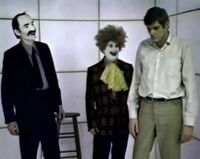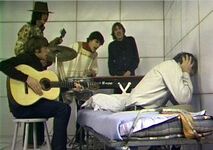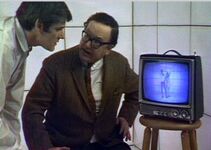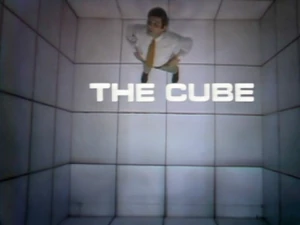
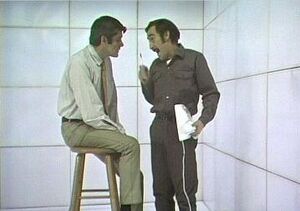
"The Man" meets Arnie
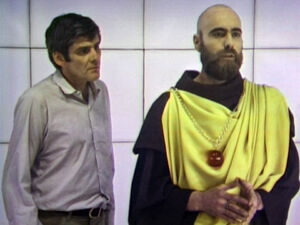
Jerry Nelson as the monk
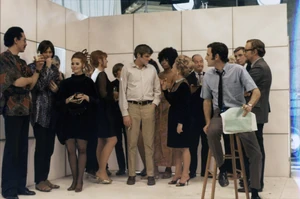
Behind-the-scenes on The Cube
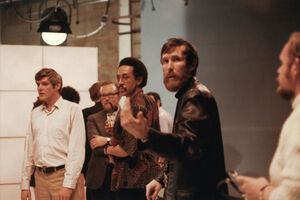
Jim Henson directing The Cube
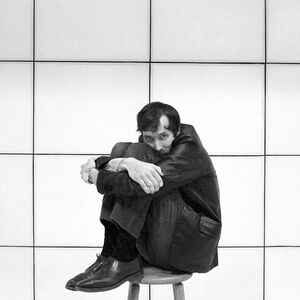
Jim Henson, promotional photo
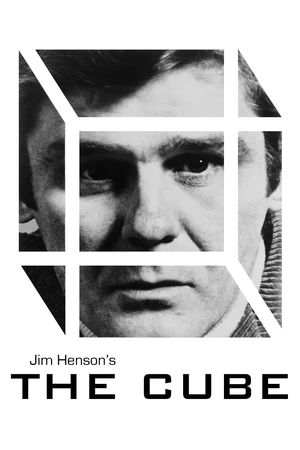
iTunes cover
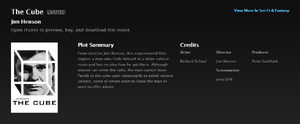
iTunes product page
The Cube was an avant-garde drama written for television by Jerry Juhl and Jim Henson, which premiered on NBC in 1969. The script was initially written in 1966,[1][2] but didn't receive funding until 1968,[3] and was later filmed at CFTO Television studio in Toronto, Canada[4] from February 10th-15th, 1969.[5]
The hour-long piece takes place within a single set: a white, cubed space composed of a series of rectangular panels, in which the nameless protagonist is trapped. A steady stream of characters enter the cube, with recurring visits by the maintenance man Arnie and Mr. Thomas the manager, but they all exit through "their own door." Some visitors seem to know the man or want to offer advice and all are generally unhelpful to the man as he tries to unravel the mystery of where he is, how he got there, and how he can leave.
Topics explored include the definitions of reality and sanity, racism, sexuality, spiritual exploration, and the nature of freedom and being trapped, as well as many meta-theatrical references to the play's status as a television drama.
Release history
- The Cube premiered on NBC as part of the anthology series Experiment in Television on February 23, 1969 at 4:30pm.[5]
- NBC rebroadcast the program two years later, on February 21, 1971.[1]
- The Henson Company released The Cube on the iTunes Store in July 2008, but it was removed sometime around the beginning of 2016. It remains the only commercial release to date.
Reception
Writing for The Milwaukee Journal on March 3, 1969, Gerald Kloss opined that scribes Henson and Juhl "would appear to be very pessimistic about solving the identity crisis problem in our society." He continued, "If that, indeed, was the theme of the show, it could have been arrived at in half the time, for the succession of weirdo scenes became less interesting as they went on. Some were funny or ominous of themselves, while others were merely arch, and most of them could have been rearranged at random without any damage to the play's continuity. Writing about illusion requires the highest of dramatic discipline, and that, believe it or not, is a reality."[6]
Robert W. Racine, writing for the Mass Media Ministries newsletter following the 1971 broadcast, was more forgiving in his review. Racine is enamoured with the big questions The Cube asks, and notes that "the brilliance of it lies in the very singularity of its basic conception. It would have been extremely difficult to prevent the idea that it is from working." He continues to describe the film's reminder "that man is both amused and plagued by ambiguity. There is nothing in all creation that has only one possible meaning or interpretation. This goes double for everything (well, almost everything) in The Cube." Racine further observes that "The life span of the average person has some things in common with the cube. We are boxed in by our ignorance, fear, and helplessness. As biological existence may be theoretically reduceable to one cell, so mankind's awareness can be too. Life for us begins with what we see and touch, but beyond that it is largely a matter of how we put it all together. This man's fearful confusion gradually gives way to angry determination, the latter reaching its fullness when he comes to realize that the first reality he has to affirm is himself."[7]
Trivia
- Jerry Nelson appears as a monk, to provide spiritual comfort to the man. The monk tells him that "All is all. Is is." This line would be repeated almost twenty years later by Cantus the Minstrel in an episode of Fraggle Rock.
- NBC's Experiment in Television had previously broadcast Jim Henson's documentary Youth '68.
- During the encounter with the professor, discussing television drama, the joke credits for The Cube, displayed on a TV set within the main scene, show "Produced by: Don Sahlin" and "Directed by: Joseph Raposo."
- Both The Cube and Time Piece feature brief scenes involving gorilla suits. The suits proved difficult to find in Canada for the latter, forcing production to import them from the United States.[5]
- Excerpts from the guitarist's song, prior to the negative "you'll never get out" passage, were included in the 2005 book It's Not Easy Being Green. The audiobook version featured Jerry Nelson reading the lines.
- Jerry Juhl makes an on-screen cameo in a projected party scene, and joins in on a conversation (presumably about The Cube), adding that he didn't care for the ending.
- In 2007, the Glassbooth Company performed a live stage production of "The Cube" at Germany's Freies Theater entitled "Kubus". (YouTube)
Credits
Cast
- The Man in The Cube: Richard Schaal
- Arnie: Hugh Webster
- Manager: Rex Sevenoaks
- Prisoner: Jack Van Evera
- Straight Man & Sergeant: Jon Granic
- Comic & Fritz: Guy Sanvido
- Seductress: Eliza Creighton
- Black Militant: Don Crawford
- Scientist: William Osler
- Monk: Jerry Nelson
- Decorator: Sandra Scott
- Dr. Conners: Claude Rae
- Professor: Don McGill
- Guitarist: Ralph Endersby
- Liza 1: Trudy Young
- Liza 2: Ruth Springford
- Father-in-law & Dr. Bingham: Moe Margolese
- Mother-in-law & Mrs. Stratton: Alice Hill
- Margaret: Loro Farell
- Dr. Bradowski & Old Man: Eric Clavering
- Nurse: Jean Christopher
Crew
- Written by: Jim Henson, Jerry Juhl
- Directed by Jim Henson
- Produced by Jim Henson
- Casting: Pat Barney
- Set Design: Jack McAdam of Design Service Associates
- Electronic Music: Walter Sear
- Associate Producer: David Robertson
- Production Assistant: Joan Chilcott
- Unit Manager: Jack Spiers
- Floor Director: Gerry Bean
- Make-up: Carol Davidson, Janet Nethercot
- Set Dressing: David Jaquest, Gerry Holmes
- Hairstyles: Max Axler
- Technical Director: Jay Gellner
- Lighting Director: Howard Galbraith
- Audio: John Grimsditch
- Video: Percy Brinkworth
- Video Tape Editing: Keith Robinson, Ed Brennan
- Production Facilities: Glen-Warren Productions Limited, Toronto
Sources
- ↑ 1.0 1.1 Jim Henson's Red Book 2/21/1971 – ‘Re-play “The Cube” – NBC.’
- ↑ Jim Henson's Red Book 10/-/1966 “Wrote ‘The Cube’ with Jerry – NBC rejected”
- ↑ Jim Henson's Red Book 2/23/1969 – ‘Sunday, 4:30 p.m. Air- “The Cube.”’
- ↑ Jim Henson's Red Book 4/–/1971 – ‘Editing VTR in Toronto for first screening April 26.’
- ↑ 5.0 5.1 5.2 Jim Henson's Red Book 12/30/1968 – ‘Go-ahead Cube.’
- ↑ Google News Archive
- ↑ Cleveland State University Library

